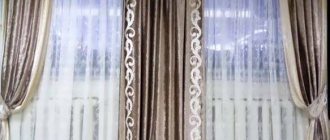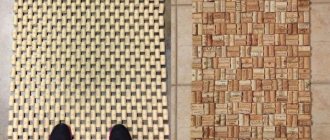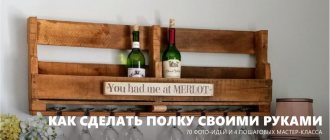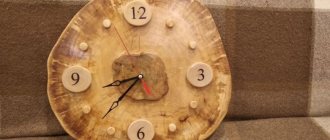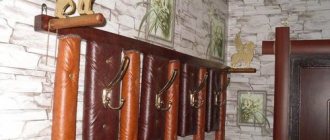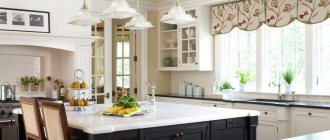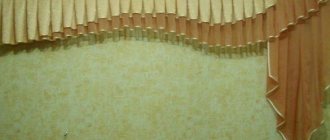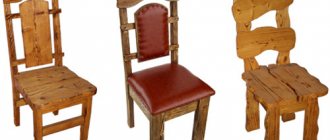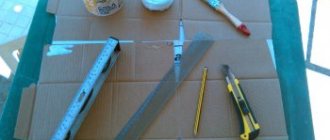Patterns for lambrequins
Decorative panels can be different - with different draperies, ties, swags. To sew their more complex shapes, you must first make a pattern. To do this, you first need to understand the basic concepts and design elements:
Pattern option for classic curtains with a lambrequin:
- Half-swags
are the same semicircle, but with a hole at the top. - Jabot (de jabot)
- side elements with a bevel and folds. They are used to outline the window border:
Tie
- if you sew two frills along the side seam, you will get this element. It has a spiral drapery and is usually used for decoration between swags or edges.
Step-by-step pattern making:
- Be sure to leave allowances: for the side edges and top edges, 2 cm is enough, for the bottom edges, at least 10 cm.
- Depending on the elements, allowances will be different. For example, for swag, a semicircle is drawn on paper and folds are laid, while at the same time calculating how much material is needed to sew the panel. For a frill, the length in height is calculated experimentally, and then the number of frills is calculated horizontally.
Properly constructed patterns will help you avoid mistakes when cutting and calculate the amount of textiles needed.
Required skill level
Beginning craftswomen or craftsmen are not recommended to choose models that are complex in cut, for example, consisting not only of swags (loosely hanging semicircles), but also molds and de jabot. It is better to opt for a regular soft lambrequin with a curved shape.
More experienced craftsmen can sew additional decorative elements using special patterns:
Scheme for constructing a mold
Pattern de jabot
Swag turning into de jabot
Do-it-yourself rigid panel model
You will need a wooden box for it. If it is heavy, then choose a closed box to provide more reliable support. Parts of the box: Shelf, brackets (fastening), facade. The facade is made of wooden boards, plywood or fiberboard.
When choosing material for a box, they are guided by the rule: the heavier the panel, the stronger it should be.
- Textiles that are cut out according to a template, not forgetting to leave allowances along the entire length - 5 cm.
- Padded, thin foam. It is cut to the size of the panel with an allowance of 3 cm along the entire length.
- Lining fabric, cut according to a template with a 1.5 cm seam allowance along the entire length.
- Stapler and paper clips, glue.
Here are some patterns for patterning hard lambrequins like de jabot:
- The padding is glued to the front and sides of the box. It is cut at the bends. Then the padding is folded back (left on the edge) and carefully glued.
- The fabric is placed on the prepared base. If a canvas with a large pattern is selected, then it is shifted to the center. The allowance (it should be about 2 cm) is folded over and secured with a stapler to the top of the box, starting from the center and moving towards the edges.
- Then do the same with the bottom edge, so that the fabric does not bristle at the bends; it is carefully cut. The bottom edge can be decorated with piping, then it is sewn on by hand.
- The lining fabric is applied to the inside with the right side up. The allowances are folded inward and secured with a stapler.
Here is a finished rigid lambrequin of a simple straight shape:
Step-by-step photos of how to sew a rigid lambrequin are offered in the following video:
We take into account all the details
The width of a roll of light fabrics (such as tulle, organza, veil) is usually 2 m 80 cm. If the height of the future curtain fits within these figures, then it is not difficult to calculate the number of linear meters required when purchasing.
The situation with curtain fabrics is more complicated - their rolls come in different widths: 1 m 40 cm, 2 m 80 cm, 3 m. In the case when the height of the curtain (in other words, its length) fits into the width of the roll, the footage is determined in the same way as indicated.
If the width of the roll is less than the length of the curtain, then the curtains will have to be sewn together from several pieces of fabric. In a financial sense, it is more burdensome. The number of canvases will also depend on the assembly coefficient and the pattern on the material. When connecting the canvases, the pattern must match - you will need additional centimeters to match the pattern.
If the curtains have a large print, then the number of meters purchased increases by the height of the repeat - a repeating pattern. And this applies to every panel. For example, both curtains have a total length of 5 m. The height of the repeat is 30 cm. We calculate how many meters of fabric will have to be purchased: 5 m + 30 cm + 30 cm = 5 m 60 cm.
Calculating the size of a curtain for a window seems difficult only at first glance. Difficulties disappear when you know how to do it.
What is a bando?
A lambrequin made on a frame or rigid base is called a bandeau. It is made from non-woven materials and can be smooth or openwork. Such a lambrequin, fixed above the window level, visually increases the height of the room. The effect of a spacious room can be achieved by placing the gang wider than the window opening.
An openwork lambrequin does not have to be hard, but if it is made on an adhesive basis without folds, it is considered rigid.
Diagram of a typical lambrequin on a rigid base.
There is a common technology by which it is quite easy to make a lambrequin with your own hands. To do this, a shape is cut out from the base material, then it is glued onto the fabric and processed in a certain way, depending on the expected result. The process of making an openwork bandeau is considered labor-intensive, but if you have patience, you will end up with a wonderful decoration for the bedroom, living room or kitchen. You can sew a lambrequin with your own hands only if you have a sewing machine and an overlocker.
For beginners, it is better to choose a simple model and not use loose fabrics, as you will have to tinker with them.
The following materials will be needed:
- self-adhesive or hot-melt bando;
- main fabric;
- lining;
- duct tape;
- braid or cord for finishing.
To make an openwork lambrequin, it is best to use a hot-melt adhesive bando. This type of material is used most often. It is a non-woven dense material of various thicknesses with one or two adhesive surfaces. An iron or steam generator is used to attach the decorative base fabric to the lambrequin.
Thermo-adhesive paralon is used for sewing a rigid bandeau.
A steam generator is an iron that constantly supplies steam after pressing a certain button. Its difference from a simple iron is that it keeps the temperature at the same level. This protects the fabric from deformation and ensures even decaling.
Decatting is the heat shrinking of a material. Before cutting, the fabric is treated with a steam generator on both the back and front sides. Cotton and linen need to be soaked for decatification.
When working with self-adhesive material, you must not make the slightest mistake, since when correcting mistakes, you have to tear it off, and as a result, the appearance of the product may be spoiled.
Fabric preparation and processing
The fabric chosen for sewing a lambrequin must be thoroughly wetted, dried and ironed before cutting. This measure will “protect” the finished product from deformation after the very first wash.
After this you need:
- draw a sketch of the future decorative element;
- spread the material on the floor or large table;
- cut off the edge (if, for example, fabric residue from curtains is used to sew a decorative element).
Should you hang a lambrequin at home? Is this relevant?
Yes, if you combine lambrequins with modern types of curtains (Roman, French) Perhaps, if the size of the room allows it No, this is an unnecessary clutter of fabrics
Cutting fabric
The simplest soft lambrequin can be sewn by making a pattern directly on the fabric: the waves will be drawn “by hand”. For this:
- the fabric is folded in half lengthwise and fastened with tailor's pins;
- the material is folded in half again and fastened again (along the sides, top, bottom and center);
- the resulting piece of fabric is divided in half, the central point is marked with chalk (a piece of soap);
- a perpendicular line is drawn;
- the length of the highest point of the bottom of the lambrequin is plotted on this line (for example, if the entire length of the product is 40 cm, then the shortest part may have a length of 20-25 cm);
- the right and left lower corners of the material are connected to the marked point with straight lines;
- all sharp corners are slightly rounded so that the lower part of the product has neat smooth lines;
- excess fabric is cut off.
Sewing curtains with eyelets
Master Class. We compare the cost of finished products and hand-sewn ones
Instructions
More details
How to sew Roman blinds
Step-by-step instructions for beginners and intermediates
Instructions
More details
How to make thread curtains yourself
Step-by-step master class. How much does it cost to make a curtain with your own hands?
Instructions
More details
DIY roller blinds
Step-by-step instructions for making roller blinds
Instructions
More details
Basic tools for creating window decorations
- The fabric chosen for the given room, lining material - if necessary.
- Threads (it is more convenient to baste with bright ones, matching the color of the fabric - for sewing).
- Needle, scissors, pins, etc.
- Sewing machine.
- Ruler and chalk, tape measure.
- Most likely you will need bias tape and a border with fastenings for the cornice, but here it all depends on the chosen shape of the lambrequin.
- Experience. If you have no sewing skills at all, then they will be difficult for a novice needlewoman. It’s worth choosing the simplest option, without decorative elements, to begin with.
- Availability of space. Since the work is quite voluminous, the floor will be an ideal option if there is no large table.
Openwork products and window sizes
An openwork lambrequin can visually change the dimensions of the window. The product, located across the width of the entire window opening, visually lengthens it. So, in order not to lose proportions and not end up with a narrow and high window, you need to choose an elongated cornice: the curtains should frame the entire window, without covering it even a centimeter!
A very narrow window can easily be hidden with a combination of folded curtains and lace. Drapery will remove excess space without causing a feeling of clutter thanks to its exquisite pattern.
As for the main selection criteria, here you need to take into account:
- Size. The width of the lambrequin will depend on the visual size of the window opening you ultimately want to achieve. If the window is small, then the openwork lambrequin must occupy the largest part of the wall.
- Form. If the room is small, then the pattern of the product should be simple. It must be chosen based on the style of the room.
- Color. In this case, it is enough that the openwork lambrequin is in harmony with the color scheme of the curtains.
In other words, an openwork lambrequin is an ideal option to diversify the interior of a room. Take the time to sew this product, and then your room will sparkle with new colors.
Folds
Folds are:
Jabot. Soft one-sided folds on one side, and on the other in the form of a falling wave. The shape is oblique, multi-layered, double. The cut and sewing is very simple, which makes it possible to widely use it in decorating curtains.
13
Swag. Freely sagging arcuate horizontal folds. Sometimes there are also vertical ones. Can be framed with decorative elements.
Transfer. A decorative element included in the combination of most lambrequins. In form it is the same swag, only there is a certain space between the arcs in this element. Easy to make and looks great in any combination.
12
Tie or bell. A narrow strip of fabric folded vertically. In appearance it resembles a men's tie.
Coquille. A decorative detail like a frill is only doubled. It can be with an elongated middle or vice versa. The folds are made in opposite directions.
Cafe style curtains
Cafe style curtains are a transformation of Soviet era curtains influenced by the romantic Provence style. Essentially, these are kitchen curtains with a modern design.
These curtains are convenient to use in small rooms. Short, they create a cozy homely atmosphere. Usually the height of such curtains is up to the middle of the window. Sometimes a lambrequin is made to accompany them. The curtain fabric is attached to the cornice using hinges (hidden or decorative), rings with clips, curtain tape, and eyelets.
Product care rules
Decorative strips are a type of textile product that, due to the nature of its design, is difficult to wash
To care for them, just carefully remove dust from the outer and inner surfaces of the product with a damp cloth or vacuum cleaner. To straighten the parts, you can use the iron in steam mode
You can iron only from the front side. In case of severe contamination, the products can be professionally dry cleaned.
Lace decorations go well with various appliqués that can be sewn on with a needle or glued. Curtains with an openwork lambrequin emphasize the elegance of the window composition and perfectly complement the interior. The advantage of lace products is the pattern, made with taste and attracting with sophistication and sophistication. The seamless lambrequin does not accumulate dust, does not require washing, does not deform and is practical to use.
The main advantage of lace frill is its universal use in any room: without weighing down the design of the curtains, openwork lambrequins add luxury to the decor and bring a touch of variety to it.
Save
Peculiarities
Having returned to fashion, figured lambrequins have won fans all over the world. Thanks to their diversity, carved designs can fit into any room design.
However, due to some production features, an openwork lambrequin is not suitable for every room.
In the bathroom, due to constant humidity, fabric models will quickly become unusable, losing their shape; it is permissible to use only plastic without fabric lining.
In the kitchen, caring for carved items will be complicated by the constant ingress of grease. In addition, fabrics strongly absorb odors. Even the most modern ventilation and exhaust systems do not guarantee safe
How to properly attach lambrequins?
You can attach this item without the help of a specialist. To do this, you should follow the basic advice given by experienced professionals, namely:
- degrease the surface of the cornice;
- the tape is glued along the cornice with the sticky side facing it;
- The tape is glued to the lambrequin with the hard side.
An openwork lambrequin usually comes complete with adhesive tape on one side and Velcro on the other
As you can see, the whole process takes just a few minutes. You just need to do all these three steps carefully and strictly follow all the requirements.
If you attach the lambrequin correctly, and also select it according to the established rules, the room will turn out to be very stylish and sophisticated. The owner of the premises will be able to boast of his excellent sense of taste. This decor is quite cheap, which will also please many owners of their own homes or any other premises. If any difficulties arise during the process of attaching the decor, you can always use the video instructions, which explain everything in detail.
Beautiful ideas for decorating windows in the interior
Typically, in wide rooms, models with a variety of decorative elements are used. The more complex the design, the fewer patterns there should be on the material, otherwise you can overload the interior of the apartment.
The bandeau model is the least “whimsical” type of rigid lambrequin. It is suitable for different window openings and doors. When choosing, you need to pay attention to the width.
Interesting ideas for decorating windows in rooms
If there is too little light in the room, then you can purchase transparent material that will ideally transmit daylight.
You may be interested in this Advantages of striped tulle: which fabric to choose
Note! Classic fabric models are very popular. However, they require special care. For those who don’t have time for this, you can choose openwork and figured models. They are attached to the cornice using self-adhesive tape.
General view of the finished decoration
Combined and openwork lambrequins. In the photo below we see a combination of hard and soft with elements of lambrequins.
You will need: dublerin, fabric, a template with a pattern, parchment paper, glue web, soldering iron, scissors and pins, plus an iron.
The calculation of materials is identical when creating a rigid one:
- The pattern should be the same size as our product.
- We apply the pattern onto the dublerin with a pencil; it is more convenient to secure it with pins or needles.
- We cut out our pattern on the lining fabric.
- On a convenient surface we lay parchment with silicone coating, then a compacted pattern, and on top - an adhesive web
- We lay out the material with the front side and iron it with a hot iron very carefully and on both sides. The cobweb will be the connecting link when gluing the material and the base.
- We take a soldering iron and trace along the edges of the pattern, the fabric is separated, and the figured lambrequin is ready.
Now let’s look at the variety of photos of do-it-yourself lambrequins, where everyone can choose their own sample or similarity for themselves and their desires.
Materials
When choosing fabrics for creating soft lambrequins, you should be guided by the style of the room. The choice of curtains must also be taken into account.
Light voile lambrequins look good in rooms with high ceilings. However, this rule can be circumvented by mixing light fabrics with heavier curtains. In a living room setting, it is usually welcome if the lambrequin is created from fabrics in contrasting shades.
Other popular materials include:
Rigid bandeaus with a frame are made from natural fabrics. Linen, cotton, chintz look good, expensive and at the same time restrained and strict. Bandeaus with a soft frame can be made from any material, but preference should still be given to polyester. It is easy to care for and costs much less than natural fabrics.
Openwork bandeaus, on the contrary, should be chosen only from plain fabric. The exception is canvases with a gradient or currently fashionable chameleon fabrics that change color depending on the lighting
Pay attention to its texture: the rougher it is, the thinner the openwork should be. Soft and hard lambrequins can also be made from fabric with a pattern.
Veil
Lightweight, simple material, originally developed for making curtains. He copes with his tasks well. It does not block direct sunlight, but diffuses it, making the rays soft and pleasant.
The veil can be in different colors, which makes it universal. There are also gradients that smoothly flow from one shade to another. The fabric does not lose its saturation over time.
Another ability of the veil is natural drapery. Unlike natural materials, it does not wrinkle and is not prone to fractures. Folds in a neat cascade, without preparing fabric, starch or wax.
Organza
A tough, coarse thin fabric made from silk, polyester or viscose. In the traditional recipe, two fibers are mixed. The resulting fabric is transparent, diffuses light well, and is very light.
There are two types:
- Matte. Opaque material, slightly textured to the touch. Organza of this type is suitable for windows on the sunny side.
- Brilliant. The surface is bright, glows in the sun, glitters. Often used in children's rooms.
Processed by etching, embroidery or printing. Decoration is made using perforation or laser cutting.
Felt
Felt fabric can be based on natural wool or plastic threads. The material is dense, painted in different colors. It is attached to the cornice using a special adhesive layer.
Felt is not prone to fading in the sun. An openwork bandeau is often made from felt. The only drawback of a felt lambrequin is that it cannot be washed. Dust, pet hair, small debris - all this sticks and gets tangled in small threads and it is impossible to wash off the dirt in the machine.
It is better not to hang curtains in the kitchen with an openwork felt lambrequin, as grease splashes will settle on the surface of the fabric.
Chiffon
Lightweight, flowing fabric made from a cotton or silk base. Simple curtains are made on the basis of chiffon. Can be combined with any type of curtains. Easily replaces regular tulle.
The palette includes warm, cool and neutral shades. Chiffon textiles can be used in any interior, from classicism to modern and high-tech.
Curtains with a lambrequin for a bedroom made of chiffon will be comfortable, as they will fill the room with freshness. They are convenient in design, as they offer a lot of colors.
Atlas
Silk-based material with bright shine and expressive color. Satin fabric looks impressive in the living room or bedroom. Density allows you to protect the room from light.
Curtains with a rigid lambrequin for the hall will protect from the sun at its zenith. Satin is durable, difficult to tear or cut, so it is not afraid of pets.
The fabric can be washed in a machine on the appropriate cycle. To get rid of shine, satin can be combined with a regular veil or chiffon.
What types of fabrics can you sew from?
For the manufacture of original models, a bandeau base made of material for curtains with pile is used. It is quite soft and glossy.
Important! The material, pleasant to the touch, can be easily cleaned from various contaminants. Over time, the fabric does not lose its attractive appearance.
You may be interested in: Is it possible to make liquid skin yourself and how to use it?
Soft belongs to curtain fabric. The material has a special coating that looks like pile. Thick fabric resembles velor or velvet.
What type of material is used for manufacturing
Chanzelize is a type of double-sided curtain fabric. The material feels quite smooth to the touch. When making new products, manufacturers use only the glossy side of the material.
Patterns: we make them ourselves and use ready-made ones
To sew a rigid lambrequin with your own hands, you will need a template from which to cut out the parts from the gang.
If you are going to make a lambrequin of a simple shape, it is easier to create a pattern yourself on a 1:1 scale. It makes sense to use ready-made options in case of repetitions of some module or a very complex asymmetrical shape, which, due to lack of skills, cannot be drawn by yourself.
If you decide to make the pattern yourself, prepare the following materials:
- a long strip of paper corresponding to the size of the lambrequin. You can use unnecessary wallpaper, graph paper, whatman paper, glue together a format from office printer paper or newspapers. The last option is not very good, since the paper is too thin, and using the template you will have to trace the outline of the product on the gang.
- pencil;
- ruler;
- square;
- a compass if you will have arcs or semicircles;
- scissors or knife.
You need to build a pattern like this:
- Draw a rectangle corresponding to the maximum dimensions of the lambrequin in width and height, respectively.
- Construct an axis of symmetry if the shape is like this.
- From the completed center line, set aside the required distances to the left and right and line up the figures.
If you have previously made a diagram to scale, then you can simply measure from the lower left corner the lengths that you take from the diagram, multiplied by the scale factor. For example, on your sketch you have 3cm, with a scale of 1:10 on the pattern it will be 30cm.
If your bottom edge is made in the form of repeating shaped modules, it’s enough to build one on another sheet, and here just circle it several times.
Having mastered the creation of patterns for rigid lambrequins, you will be able to make templates of any complexity yourself. You won't have to look through a lot of images on the Internet, wasting your time. An idea appeared, they took it and implemented it, first in the pattern, then in the material.
Curtain "Cat's House"
This curtain with an arch is perfect for kitchen windows. Having no gathers along the top edge, it lays down in beautiful folds.
The pattern for such arched curtains for the kitchen is quite simple to construct. First, let's decide on the three main sizes. They are shown in the diagram.
We draw an arc with radius R=C:3, drawing the top of the “Cat House” curtain.
Set aside dimensions A and B. Connect the extreme points with a smooth line.
How to sew curtains for the kitchen
Using the completed pattern, we cut out the curtain blank with allowances. We process the bottom edge by bending the allowance. You can use facing or fringe.
We fold the side sections with a double hem and stitch them. We sew a curtain tape with loops or a drawstring onto the top edge.
What to consider when choosing?
- Hard bandeaus are not washable. Cleaning only with a vacuum cleaner is allowed. As a last resort, use a soft microfiber cloth soaked in a cleaning solution that leaves no residue. However, wet cleaning can lead to streaks, delamination and complete deterioration.
- Soft items need to be washed frequently. Dust easily settles in folds. However, for washing, a delicate cycle without spinning is used.
- When purchasing combined models, soft lambrequins must be removable. Otherwise, problems will arise during cleaning. It's a bit expensive to have your textiles dry-cleaned every month. It is better to discuss all the points with the seamstress in advance than to receive a disposable and expensive item.
- Care instructions. Require it when purchasing in a store or sewing salon. You have the right to know what fabrics the product is made from and how to care for it.
- When removing the lambrequin for cleaning, take a photo of it. This will allow you to hang it the way you want later. Especially when the model contains many removable elements.
When choosing, consider the living room style, color scheme, opening features and practicality of the model.
Material selection rules
The use of fabric in the interior always involves a combination of functionality and attractiveness. The choice of material plays an important role not only from the point of view of the interior, but also from the point of view of the specifics of the kitchen.
Combine the material with the overall interior design
The fabric must have such important properties as the ability to withstand repeated washing and cleaning.
In the kitchen there is often high humidity due to cooking, there are particles of fat and gas in the air, so the ability of the material to be washed frequently is very important. If the fabric is spectacular and expensive, but at the same time requires complex care, this is not an option for the kitchen.
Choose quality fabric
For curtains with lambrequins that are located close to the stove or sink, it is advisable to look at fabric with special treatment - fire-resistant and water-repellent.
Choose practical fabric with special treatment
In many interiors, when choosing fabric for kitchen curtains, designers give preference to environmentally friendly materials:
- linen;
- cotton;
- viscose.
Synthetic compounds are used less often, dense compounds are used almost never. Heavy solid fabrics (velvet, brocade, etc.) are also not suitable for the kitchen.
They are too solemn, too elegant and heavy. In addition, they absorb odors, which makes them undesirable for the kitchen.
“Ceremonial” fabrics for room design
It’s very beautiful when the curtains in the kitchen are light, letting in enough light and not burdening the perception of space.
Use lightweight fabrics for good light transmission
Interior design ideas for a modern kitchen in a private home + 130 PHOTOS and TOP 8 trends in 2022
How to calculate length
The length of the curtain is the distance from the rod (string, rail) of the curtain rod to the selected level. The length of the curtains is chosen according to the interior style and tastes of the owners. Curtains can:
- reach the floor
- lie on the floor like a train,
- end at the windowsill,
- fall below it by 10-15 cm.
In addition, the height of the curtain is influenced by how its top edge will be processed - whether it will be curtain tape, drawstring, fabric loops or ties, eyelets, clothespins or hooks.
The curtains will have to be washed over time. All fabrics (natural ones - to a greater extent) have the property of “shrinking” - decreasing in size after washing. Linen, for example, “shrinks” up to 10% of the original parameters. To avoid an unpleasant situation, an allowance for shrinkage is made on the hem of the bottom - an additional safety margin of 5-8 cm is added. In total, 10-12 cm of allowance will go to the bottom edge.
Design and drawings
When choosing a lambrequin design, take into account the overall style of the living room. The pattern should be combined with a pattern on textiles, such as sofa cushions or curtain tiebacks.
Openwork
The openwork decor for the hall window can be hard, made using laser cutting, or soft, made of thick felt. The smaller the window in the hall, the simpler the ornament should be. For a high window in a spacious living room, you can choose a wide openwork decorative element. Very fashionable now are small contrasting lambrequins for the hall with a laconic pattern. They are suitable for any window and will decorate the living room in a modern or classic style.
In the photo, a light openwork lambrequin is contrastingly emphasized with beige curtains.
Asymmetrical
An asymmetrical design involves draping the living room window on one side. This approach may be dictated by the arrangement of furniture in the room, when it is impossible to open the window space on both sides. It is important to place draperies on one side when decorating a balcony door in the living room.
Buffs
Puffs are often used in small halls or spacious living rooms. They are located horizontally and have a smooth edge. Folds can be assembled into various options: braid, header or balloon.
The photo shows a variant of the puff - braided.
With fringe
Modern fringe design is characterized by the use of additional decorative elements - beads, glass beads, seed beads or even shells.
With tassels
Lambrequins for the hall are often decorated with tassels. They give the room a formal look.
In the photo, a simple white bondo lambrequin is decorated with large tassels
Simple
Simple lambrequins for the hall do not overload the living room, have clear lines and are suitable for small spaces. A short, narrow decorative element will visually raise the ceiling and let in sunlight.
tetrahedral shape
A tetrahedral lambrequin is a strip of fabric lined with the same or contrasting material. By changing the mounting method and width, you can create a unique image of the living room. It can have a rigid base and a contrasting pattern. A lambrequin for a hall with a bright pattern, which is used with simple curtains, looks advantageous.
With flowers
When choosing a lambrequin for a room with flowers, the characteristics of the room are taken into account. Dark colors can be added to light colors such as white, blue, pink, beige. The proportions must be respected. Large bright flowers will look out of place in a small living room. Hall decor with voluminous flowers is a fashion trend this season.
Two-color
Such lambrequins for the hall are usually built on a contrasting combination of colors. These can be light and dark alternating semicircular swags. Not only colors can be contrasting, but also materials, when a hard dark lambrequin is combined with delicate, light fabric of curtains or living room textiles.
With rhinestones
Lambrequins for the hall can be complemented with rhinestones. The simplest decor will sparkle in a new way when using rhinestones. You can add rhinestones to your window composition at home. The currently fashionable figured lambrequins with rhinestones look very advantageous.
Fastening
The lambrequin is attached to cornices, window and door openings in different ways. There are fastenings with loops and ties. These are fasteners presented in the form of satin, satin bows, silk ribbons, rope cords or cotton laces.
Tie fastening
There is a lambrequin fastening to the eyelets. These are metal or plastic rings, available in different colors and sizes. Consists of a block and a leg. Art Nouveau, shabby shake and even vintage interiors are aesthetically complemented.
Eyelet fastening
Note! There is also a tape mount. This is a decorative fitting that allows you to attach curtains to cornices and openings using glue and Velcro. The most common model on all types of lambrequins.
In general, a lambrequin is a decorative transverse fabric strip that can be used to decorate window and door openings. They are able to give the room the effect of luxury and wealth. This design can not only make the room beautiful, but also emphasize its style, becoming a highlight. Lambrequin can be classic, soft, openwork, modular, plank and asymmetrical. Also available in bondo form. Can be decorated with a swag, half-swag, perekid, jabot, tie and puff. Easy to sew using the classic pattern and detailed instructions. Attaches with loops, ties, eyelets and Velcro strips.
How to sew an openwork lambrequin with your own hands
You can make your own lambrequins with patterns for beginners using the instructions below.
To do this you will need the following:
- Main fabric.
- Intermediate lining.
- Bando. An openwork bandeau is the basis that is used for sewing curtains. It has centimeter and millimeter marks that will help you make an even cut.
- Fringe overlays.
- Thread.
- A2 paper.
- Scissors.
Next you need to follow the step-by-step plan:
A sketch is prepared and transferred to paper. After this, everything is cut out using regular scissors. You need to be careful, since subsequent transportation depends on the quality of the cutting. If there is no drawing that fits in size, you can use graph paper. It will help maintain proportions and enlarge the drawing to the desired size and transfer it without loss. The most commonly used drawing paper is drawing paper (it is denser and stronger than regular paper). If you don't have one, thick wallpaper will do.
The resulting sketch is transferred to the gang. Now you need to glue the main fabric. You need to be careful here to avoid bubbles.
It is important that the material is synthetic. Unlike natural ones, they are not prone to shedding and threads do not come out of them
In addition, natural fibers are prone to starching. And this can lead to peeling and disintegration of the lambrequin.
- Using adhesive web you need to glue the backing.
- At this stage you need to find a cutting method. Using scissors will not work, since the edges will be uneven in any case. The best way is laser cutting. You cannot do this yourself, so you will have to take it to a studio that provides such services. The edges are smooth, do not require editing, and no fraying is created. You can use the thermal processing method. To do this you will need a wood burner. It develops a high temperature and instantly burns a small section that is not noticeable. The thinnest nozzle is used, which is quickly passed through the stencil.
- A seam is placed along the edge.
This is a brief manufacturing instruction. You will notice that figured lambrequins are made in just one evening from any fabric. You can watch a master class on openwork lambrequins.
We sew a lambrequin
- After the basic work has been done, it is time to stitch the edges. The easiest way is a sewing machine or overlocker. To do this, you can go to a studio and stitch the edges. You need to take two centimeters from the edge and stitch it, skipping the seams. As a standard, a regular seam is used, which is not covered or decorated with anything. This is the simplest solution that shows an acceptable result. It is best to make a small stitch with thread of the same color.
- In addition, you can use bias tape. In this case, omissions should not be made. It is rarely used, especially if the lambrequins have a complex shape with a lot of bends. In this case, creases will definitely appear. Coupled with the painstaking work, its duration and complexity, the result may be unsatisfactory.
- If you don’t have a sewing machine or overlocker, you can always use regular thread and a needle. The work is much more painstaking and requires more effort, but otherwise it will help to sew lambrequins. Here you can use a thread of the same color as the main material. The stitch should be small and consistent. Since there is no load on the decoration, you can use thin threads. Including fishing line for bead embroidery.
- Lastly, the fringe is installed. It is stitched with a thin stitch in random places. It especially hides imperfections in the binding, creases and poorly stitched areas. It is already sold in whole strips.
French curtain - awning
To make it, you need a special braid, in which the gathers are fixed and do not slide under their own weight.
The dimensions of the workpiece should be 1.5 times the width of the finished part and 2 times its height.
Let's look at sewing a pattern for a French curtain made of crystal.
The dimensions of the finished product are 1.6 x 2.5 m.
Accordingly, the dimensions of the workpiece are 3.75 x 3 m, taking into account rounding and allowances = 4x3 m.
We take the distance between the rows of assemblies to be 50 cm. After simple calculations, we determine that 9 rows require 27 m of tape for assemblies.
For the top, you need another 4 m of braid when making assemblies, and if you plan to lay folds, then you need 2.6 m of braid.
Let's start sewing. We mark the lines for sewing the braid, pulling out at intervals of 50 cm along the thread.
We tie one end of the braid knots with a knot and melt it.
Sew on the braid starting from the bottom edge. If we are going to trim the bottom of the curtain with trim, then we align the braid along the cut of the bottom, and if we are planning a hem, then we attach the braid, taking into account its width.
We attach one edge of the braid, then the second. In this case, the sewing line should be along the axis of the braid.
Repeat for side cuts.
Having sewn all the braids, we turn and sew the bottom seam allowance.
Place folds along the top edge. The original width of the fabric was 4 m, of which 4 cm was used for hems. The remainder is 3.96 m. Having subtracted the width of the finished curtain (= 2.5 m), we determine that there are 1.46 m left for the folds. Divide by 8 and we get 18.25 cm for each fold. Round up to 18 cm. We make a counter fold of 9 cm above each braid, and a simple fold of 9 cm on the sides.
We attach the braid.
We tighten the ribbons to the desired curtain size.
The work is done!
If you wish, the top edge can simply be gathered on the curtain tape.
